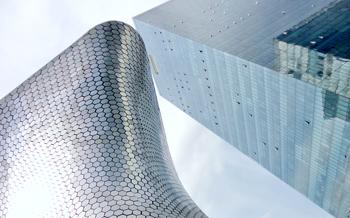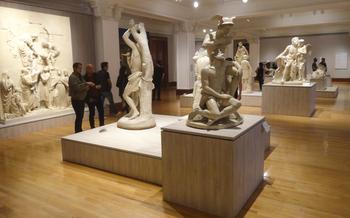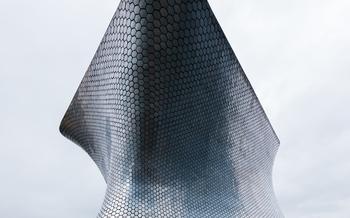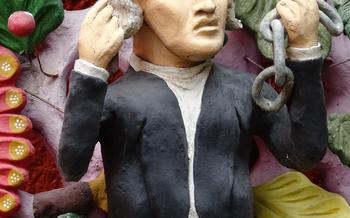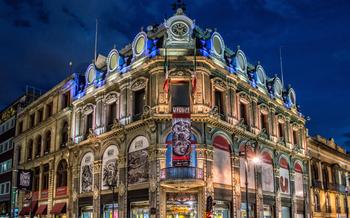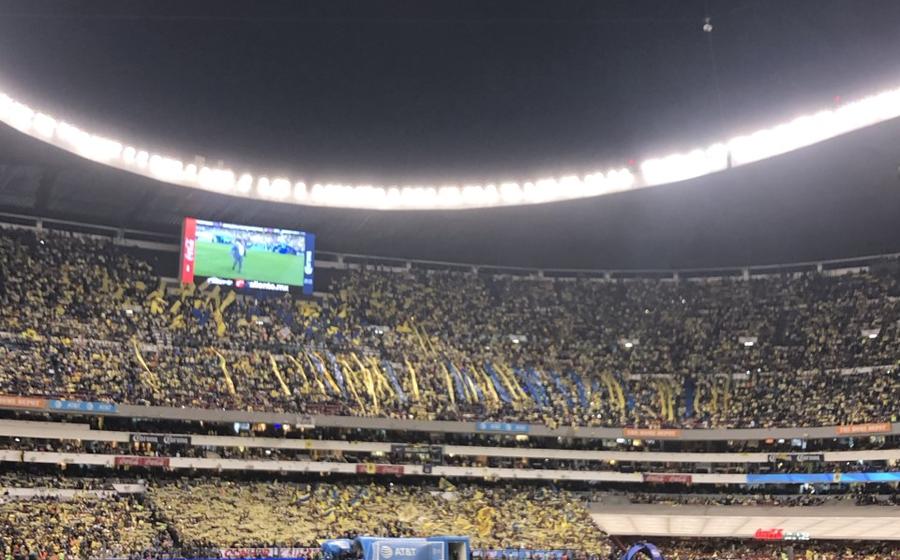
Estadio Azteca
- Estadio Azteca: A Symbol of Mexican Football
- Location and Accessibility
- Guided Tours and Experiences
- Museo del Fútbol (Football Museum)
- Attending a Football Match
- Concerts and Events
- Estadio Azteca's Legacy
- Security and Safety Measures
- Local Cuisine and Restaurants
- Shopping and Souvenirs
- Family-Friendly Activities
- Photography and Social Media
- Accessibility for People with Disabilities
- Volunteering and Community Involvement
- Insider Tip: Behind-the-Scenes Access
Estadio Azteca: A Symbol of Mexican Football
At the heart of Mexico City, nestled within the bustling neighborhood of Santa Úrsula Coapa, stands the Estadio Azteca, a colossal monument to the passion and fervor of Mexican football. Inaugurated on May 29, 1966, this awe-inspiring stadium has witnessed countless moments of glory, etched forever in the annals of Mexican football history.
With a colossal capacity of over 87,000 spectators, the Estadio Azteca is a testament to Mexico's enduring love for the beautiful game. Its architectural design, a masterpiece of modern engineering, features a unique elliptical shape, ensuring an intimate and immersive experience for every fan. The stadium's iconic twin towers, reaching towards the sky like beacons of footballing excellence, have become synonymous with the indomitable spirit of Mexican football.
Over the decades, the Estadio Azteca has played host to some of the most iconic moments in Mexican football history. It was on this hallowed ground that Mexico's national team achieved its greatest triumph, lifting the FIFA World Cup trophy in 1970, a moment forever etched in the hearts of every Mexican football fan. The stadium has also witnessed countless heart-stopping matches, dramatic comebacks, and unforgettable goals, cementing its place as a true symbol of Mexican footballing pride.
Location and Accessibility
The Estadio Azteca is strategically located in the southern part of Mexico City, within the vibrant neighborhood of Santa Úrsula Coapa. This neighborhood is known for its lively atmosphere, with a mix of residential areas, commercial establishments, and cultural attractions.
Reaching the stadium is relatively easy, thanks to the well-connected public transportation system. The Metro (subway) is the most convenient option, with the Estadio Azteca station on Line 12 (Golden Line) providing direct access to the stadium's entrance. Alternatively, several bus routes stop nearby, offering affordable and direct connections from various parts of the city.
For those who prefer to drive, the stadium provides ample parking facilities. The surrounding area offers multiple parking lots, both official and privately operated, ensuring convenient and safe parking options for visitors.
Guided Tours and Experiences
The Estadio Azteca offers a range of guided tours in multiple languages, providing visitors with an in-depth look into the stadium's history, architecture, and significance. These tours typically last for about an hour and are led by knowledgeable guides who share fascinating stories and anecdotes about the stadium and its iconic moments.
During the tour, visitors will have the opportunity to explore the stadium's various areas, including the players' locker rooms, the press box, and the VIP suites. They will also get a chance to walk through the tunnel leading to the pitch and experience the thrill of standing on the same ground where legendary footballers have played.
In addition to the standard tours, the Estadio Azteca also hosts special events and activities throughout the year, such as meet-and-greets with former players, football clinics for kids, and themed tours focusing on specific aspects of the stadium's history. These special events offer a unique opportunity for fans to engage with the stadium and learn more about its rich legacy.
Museo del Fútbol (Football Museum)
Nestled within the Estadio Azteca complex, the Museo del Fútbol is a must-visit for football enthusiasts and history buffs alike. Dedicated to preserving and showcasing the rich heritage of Mexican football, the museum offers an immersive journey through the sport's most iconic moments and legendary players.
As you step inside the museum, you'll be greeted by an array of interactive displays and multimedia experiences that bring Mexican football's history to life. Learn about the origins of the sport in Mexico, the evolution of the national team, and the unforgettable triumphs and heartbreaks that have shaped the nation's footballing identity.
The museum houses an impressive collection of memorabilia from legendary players and teams, including match-worn jerseys, boots, and trophies. Admire the iconic "Shirt of the Century," worn by the legendary Hugo Sánchez during the 1986 World Cup, or marvel at the gleaming trophy that Mexico lifted as champions of the 1999 FIFA Confederations Cup.
Whether you're a lifelong fan or simply curious about the passion that drives millions of Mexicans, the Museo del Fútbol offers a captivating and educational experience that will leave you with a newfound appreciation for the beautiful game.
Attending a Football Match
Attending a football match at the Estadio Azteca is an unforgettable experience that captures the essence of Mexican football culture. To make the most of your matchday, here are some practical tips and insights:
-
Advance Ticket Purchase: Ensure you purchase your tickets well in advance, especially for important matches or rivalries. Online platforms and official team websites often offer secure and convenient ticket purchasing options.
-
Matchday Atmosphere: Prepare for an electric atmosphere filled with passionate fans, colorful banners, and vibrant chants. The energy and enthusiasm of the crowd are unmatched, making it a truly immersive experience.
-
Fan Culture: Embrace the local fan culture by wearing the team's colors, joining in the chants, and celebrating the goals with fellow supporters. Respect opposing fans and maintain a friendly and respectful atmosphere.
-
Food and Beverages: Enjoy the wide variety of food and beverage options available inside the stadium, from traditional Mexican snacks like tacos and tortas to international favorites. Cash and credit cards are generally accepted.
Concerts and Events
Besides football matches, the Estadio Azteca also hosts a variety of concerts, music festivals, and other events throughout the year. These events range from international pop stars to local bands, ensuring there's something for everyone to enjoy.
To stay updated on upcoming events, check the stadium's official website or social media pages. You can also sign up for email alerts to receive notifications about ticket sales and special promotions.
For concerts and non-football events, the stadium may have special arrangements in terms of seating, stage setup, and security. It's important to check the event's website or contact the organizers for specific details and guidelines.
Attending a concert or event at the Estadio Azteca offers a unique and memorable experience. The stadium's massive size and state-of-the-art facilities create an unforgettable atmosphere for fans of all kinds of music and entertainment.
Estadio Azteca's Legacy
Estadio Azteca has played a pivotal role in hosting major international football tournaments, cementing its status as a global sporting landmark. It was the first stadium to host two FIFA World Cup finals, in 1970 and 1986, and has also hosted the FIFA Confederations Cup and the CONCACAF Gold Cup on multiple occasions. These prestigious events have showcased the stadium's world-class facilities and its ability to accommodate large crowds in a safe and secure environment.
Beyond its role in international tournaments, Estadio Azteca has had a profound impact on the development of Mexican football. It has served as the home stadium for the Mexican national team, Club América, and Cruz Azul, three of the most successful clubs in Mexican football history. The stadium has witnessed countless memorable matches, including Mexico's victory over Brazil in the 1970 World Cup quarter-finals, which is considered one of the greatest upsets in football history.
The stadium's iconic status and global recognition have made it a symbol of Mexican football. It has become a pilgrimage site for football fans worldwide, who visit to experience the unique atmosphere and witness the passion of Mexican football culture. Estadio Azteca's legacy as a global sporting landmark is secure, and it will continue to be a focal point for football in Mexico and beyond for many years to come.
Security and Safety Measures
The Estadio Azteca prioritizes the safety and security of all visitors, implementing stringent protocols for events and tours. Security personnel is present throughout the stadium to ensure a safe and orderly environment. Visitors are required to adhere to the stadium's security guidelines, which include restrictions on prohibited items such as weapons, illegal substances, and large bags. Additionally, specific behaviors, such as fighting, disruptive conduct, or unauthorized access to restricted areas, are strictly prohibited.
In the event of an emergency, evacuation routes are clearly marked throughout the stadium, and emergency procedures are in place to ensure the safety of all attendees. Visitors are advised to familiarize themselves with these procedures and to follow the instructions of security personnel in the event of an emergency.
By adhering to the stadium's security measures, visitors can contribute to a safe and enjoyable experience for everyone attending events or tours at the Estadio Azteca.
Local Cuisine and Restaurants
Estadio Azteca is situated in a vibrant neighborhood with a diverse culinary scene. Visitors can savor the authentic flavors of Mexican cuisine at nearby restaurants and food stalls. From traditional street food to upscale dining options, there's something to satisfy every palate.
For a taste of authentic Mexican street food, try the tacos al pastor from the renowned Taquería El Paisa, located just a short walk from the stadium. These mouthwatering tacos feature spit-roasted pork, pineapple, and cilantro, all served on fresh corn tortillas.
If you prefer a more formal dining experience, head to La Casa de las Sirenas, a charming restaurant known for its seafood dishes. Sample the delicious ceviche or the grilled octopus, accompanied by a refreshing margarita or a glass of Mexican wine.
For a budget-friendly option, visit the Mercado de Coyoacán, a traditional market offering a wide variety of Mexican specialties. From fresh produce to handmade tortillas, you'll find everything you need to create your own delicious meal.
When exploring the surrounding area, be sure to try some of the local favorites, such as pozole, a hearty soup made with hominy and meat, or enchiladas, corn tortillas filled with cheese, beans, or meat and topped with a spicy sauce.
To fully immerse yourself in the local culture, don't be afraid to step off the beaten path and try some of the smaller, family-run restaurants. These hidden gems often offer the most authentic and affordable dining experiences.
Shopping and Souvenirs
For those looking to take home a piece of the Estadio Azteca experience, the stadium offers several official merchandise stores where you can purchase football gear, souvenirs, and memorabilia. These stores stock a wide range of items, from jerseys and scarves to keychains and mugs, all emblazoned with the iconic Estadio Azteca logo.
In addition to the official stores, the surrounding area is home to a vibrant market and shopping scene. Here, you can find local artisans selling handcrafted souvenirs, such as colorful pottery, woven textiles, and intricate silver jewelry. Bargaining is expected and encouraged, so be prepared to haggle for the best prices.
For a truly unique souvenir, consider purchasing a traditional Mexican football mask. These colorful and often whimsical masks are a staple of Mexican football culture and can be found in various designs and styles. They make for a fun and memorable way to commemorate your visit to the Estadio Azteca.
Family-Friendly Activities
The Estadio Azteca offers a range of family-friendly amenities and activities to ensure a fun and enjoyable experience for visitors of all ages. Families with young children can take advantage of the designated family areas within the stadium, which provide comfortable seating and a safe environment for kids to enjoy the game.
For a more interactive experience, families can participate in the stadium's educational programs and activities. These programs, often held on weekends or during school holidays, introduce children to the history and culture of Mexican football through interactive games, quizzes, and storytelling sessions.
Additionally, the stadium hosts special events and activities tailored specifically for families. These events may include face painting, balloon art, live entertainment, and appearances by popular football mascots. Keep an eye out for these special events when planning your visit to the Estadio Azteca.
Tips for Making the Most of a Family Visit:
- Plan Ahead: Check the stadium's website or social media pages for upcoming family-friendly events and activities.
- Arrive Early: Arriving early will give you ample time to explore the stadium, participate in activities, and find your seats before the game starts.
- Bring Snacks and Drinks: While food and beverages are available for purchase inside the stadium, bringing your own snacks and drinks can save money and ensure that you have options your kids will enjoy.
- Dress Comfortably: The stadium can get chilly at night, so dress in layers and bring a jacket or blanket if needed. Comfortable shoes are also recommended as you'll be doing a lot of walking.
- Take Advantage of the Family Areas: The designated family areas offer a safe and comfortable environment for kids to enjoy the game. These areas are typically located near the restrooms and concession stands.
- Make it a Learning Experience: Use the visit to teach your children about the history and culture of Mexican football. Discuss the significance of the stadium, the rules of the game, and the passion of the Mexican fans.
Photography and Social Media
Capturing memories at Estadio Azteca is highly encouraged, but certain guidelines must be followed to ensure a respectful and safe environment for all visitors. During tours and events, photography and videography are permitted for personal use, provided they do not interfere with the proceedings or disrupt other attendees' experiences. Flash photography and the use of tripods or professional equipment may be restricted in certain areas to avoid disturbing players or spectators.
For those seeking Instagram-worthy shots, the stadium offers several stunning backdrops. The iconic exterior facade, with its bold architectural features and vibrant colors, provides a captivating backdrop for photos. The panoramic views from the upper tiers of the stadium, encompassing the sprawling pitch and the energetic crowd, are sure to impress. Don't miss the chance to capture a selfie with the iconic Estadio Azteca sign, a symbol of Mexican football's rich history.
To stay connected and share your Estadio Azteca experiences with the world, make sure to use the official hashtags and follow the stadium's social media accounts. By tagging your photos with #EstadioAzteca and #FutbolMexicano, you can join a vibrant community of football enthusiasts and showcase your unique perspective on this legendary venue.
Accessibility for People with Disabilities
Estadio Azteca is committed to ensuring that all visitors, including those with disabilities, have a safe and enjoyable experience. A range of accessibility features and services are available to make the stadium accessible and inclusive for everyone.
-
Designated Seating: Special seating areas are reserved for wheelchair users and their companions, providing unobstructed views of the field and easy access to restrooms and concessions.
-
Accessible Restrooms: Wheelchair-accessible restrooms are conveniently located throughout the stadium, ensuring that visitors with disabilities can use the facilities with ease and dignity.
-
Elevators and Ramps: Elevators and ramps are installed throughout the stadium to facilitate movement between different levels, making it easier for visitors with mobility challenges to navigate the venue.
-
Accessible Parking: Reserved parking spaces are available for visitors with disabilities, located close to the stadium entrances to minimize walking distances.
-
Assistance for Wheelchair Users: Trained stadium personnel is available to provide assistance to wheelchair users, including escorting them to their seats, providing directions, and helping with any other needs.
-
Service Animals: Service animals are welcome at Estadio Azteca, and their owners are provided with designated areas to rest and care for their animals during events.
Visitors with disabilities who require special assistance or have specific accessibility needs are encouraged to contact the stadium's customer service department in advance. The stadium staff is dedicated to accommodating all visitors and ensuring that everyone has a positive and memorable experience at Estadio Azteca.
Volunteering and Community Involvement
Estadio Azteca not only serves as a sporting venue but also plays a vital role in community involvement and social responsibility. Visitors have the opportunity to make a positive impact by volunteering their time and supporting local football initiatives. The stadium collaborates with various organizations to promote grassroots football development, youth empowerment, and social inclusion.
Volunteering opportunities include working with youth football programs, assisting with community events, or contributing to stadium operations. By getting involved, visitors can connect with the local community, share their skills and passion for football, and make a meaningful difference in the lives of young people.
The stadium also supports various social initiatives, such as promoting gender equality in sports, fighting discrimination, and raising awareness for important causes. Visitors can learn more about these initiatives and how they can contribute by visiting the stadium's website or contacting the community relations department.
Whether you're a passionate football fan or simply looking for a way to give back, volunteering at Estadio Azteca is a rewarding experience that allows you to be part of a vibrant and socially conscious community.
Insider Tip: Behind-the-Scenes Access
For an unforgettable experience, try to arrange a behind-the-scenes tour of the Estadio Azteca. While these tours are not regularly offered to the public, there are a few ways to increase your chances of getting access.
One option is to inquire about VIP or exclusive tours through the stadium's official website or by contacting the customer service department. These tours may come with a higher price tag but often provide a more in-depth experience, including access to restricted areas and the opportunity to meet with stadium officials or former players.
Another way to get behind-the-scenes access is to attend special events or promotions that the stadium occasionally hosts. These events may include meet-and-greets with players, stadium tours, and other exclusive activities. Keep an eye on the stadium's social media channels and website for announcements about upcoming events.
If you're truly passionate about football and Mexican culture, you can try connecting with local football enthusiasts or organizations. By networking with people who share your interest, you may be able to find opportunities to volunteer at the stadium or get involved in community initiatives. This can lead to unique experiences and a deeper understanding of the stadium's role in Mexican society.


